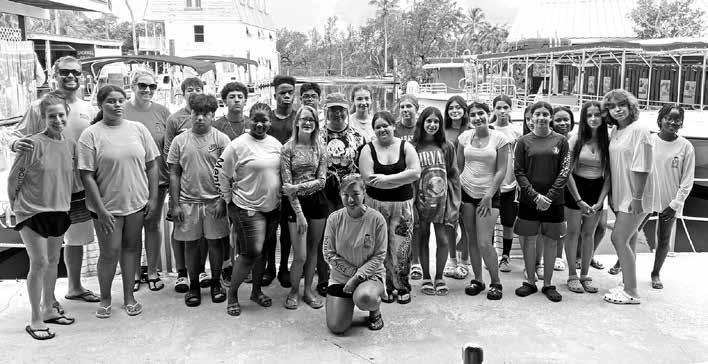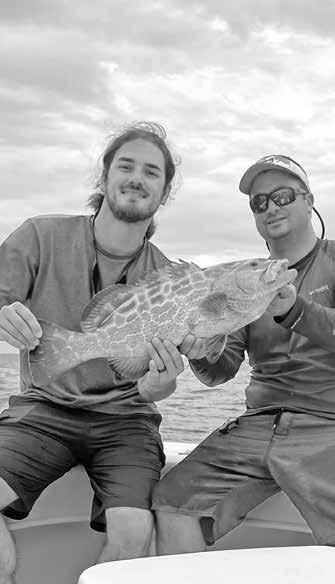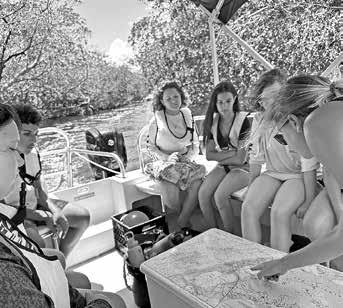
3 minute read
EXPLORING THE ENVIRONMENT
is the owner and operator of Top Notch Sportfishing in Marathon. His passions include scuba diving and enjoying the natural beauty of the Florida Keys.
The offshore mahi bite has slowly but surely been getting better over the past couple of weeks. We have been seeing a lot of small, undersized fish inshore in depths of 600 feet, and having better luck with bigger, quality fish further offshore in water 1,000 feet or deeper.
My typical spread when I am trolling for mahi is a rigged ballyhoo in each outrigger and two threeinch artificial baits on the flatlines. So far this season, I have found that the majority of fish have been eating the smaller bait that mimic the flying fish we commonly find in the stomachs of our catch at the filet table.
Fishing on the reef has not been easy lately. A combination of irregular water sediment levels and uncommon currents from a variety of directions switching daily has made fishing difficult, but not impossible. The past couple of weeks have made anglers sharpen their skills and employ lighter-tackle tactics. Yellowtail snapper and black grouper have been our target species as we patiently wait for the mangrove snapper spawn to begin in mid-July.
When it comes to catching yellowtail snapper, the first order of business is to set up your chum slick. Positioned on the reef in 40 to 90 feet of water, place your boat up current from the area you would like to fish. Start by placing your frozen block of chum in your large mesh chum hoop. I suggest starting off with at least two seven-pound blocks of chum in the water, or you can use a 25-pound block, which will last you much longer and is more cost effective. Many fishermen also add oats to their chum slicks to help raise the fish off the reef, leading to a lower chance of getting caught on the bottom.
Marinelab Welcomes 25 Take Stock Students
Although the offshore bite and reef fishing have both been challenging, there are still plenty of great dinners to be had, including this black grouper. BILL GILIBERTI/Keys Weekly

When targeting yellowtail snapper, I prefer to use a seven-foot light action rod paired with a 4500 series reel that is spooled with 12-pound monofilament. Attached to your main line, I start off with a 20-foot section of 12-pound fluorocarbon leader and double the line through the eye of the hook. Weighted jigs such as yellowtail candy can be used and are effective, but I prefer to use a plain size 6 hook with a small piece of bait, so it drifts back with the chum. Peeled shrimp is the preferred bait to catch these snapper. According to FWC regulations, yellowtail snapper must be a minimum of 12 inches total length, measured from the front of the mouth to the tip of the tail. I prefer to release any fish smaller than 14 inches since there is not much of a filet on a smaller yellowtail snapper. The limit on this abundant fish is 10 per person.
Yellowtail snapper is delicious when fried, broiled, baked, grilled, or sauteed and can be found in most local restaurants as fresh catch year-round. My personal favorite way to munch these fish is fried in a coconut batter dipped in a sweet Thai chili sauce.
Get out there and get tight!
Take Stock In Children (TSIC) recently returned to the MarineLab campus for the second year to host its annual kickoff for Monroe County students entering ninth grade.

Over the three-day visit, 25 TSIC mentees in the Keys were immersed in MarineLab’s core curriculum of seagrass, mangrove and coral reef ecology. Prior to their snorkeling field trips, students learned about the interconnectedness of the marine environment, abiotic and biotic factors affecting the organisms in each community and how to identify marine creatures from algae through invertebrates to fish.
In addition, students learned about marine debris and its impact and possible solutions, including participating in a cleanup. During labs, the mentees explored the diversity and abundance found in nearshore waters, and identified the zooplankton which make up part of the base of the food chain. MarineLab’s curriculum supports the Next Generation Science Standards and Ocean Literacy Principles.

“Overall, the kids said they loved the water and snorkeling. Some kids enjoyed the labs,” said Autumn Hager, TSIC’s student services supervisor. “Personally I love the reef — it truly is spectacular, and the instructors did a fantastic job pointing out lots of wonderful sea life.”The MarineLab Environmental Education Center, located at MM 103.2 on the oceanside in Key Largo, is the education program of Marine Resources Development Foundation, a nonprofit founded in 1970 by Ian Koblick. MarineLab uses education and adventure in the Florida Keys to foster environmental awareness and stewardship on a local, regional and global scale. In 2022 over 5,000 students and teachers in 164 separate programs attended MarineLab programs.
Since 2019, MarineLab has had groups from 29 states, including 75 schools from Florida, and teachers from the British Virgin Islands, Cayman, St. Maarten, St. Lucia, Barbuda, U.S. Virgin Islands, Vietnam and Dominica.










